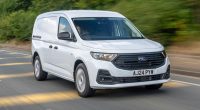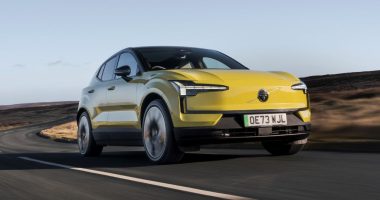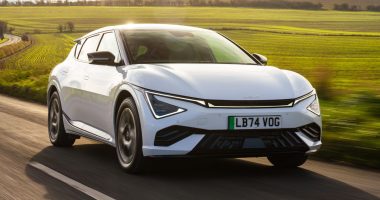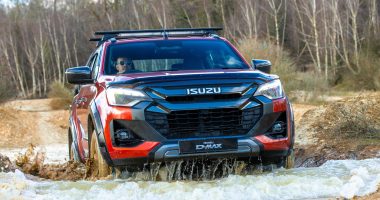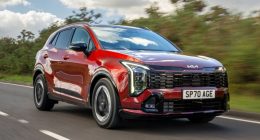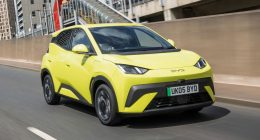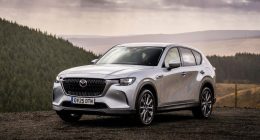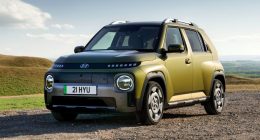Subaru’s belated arrival to the world of full electrification comes in the guise of the Solterra – a medium-sized family car that, in keeping with the Japanese company’s WRC heritage, has four-wheel-drive. Offering a battery-powered Sports Utility Vehicle has required more than a little assistance from Toyota, however – someone it has worked with previously to create the 86/BRZ sports car – because beneath the edgy styling, all of the hardware comes from Toyota.
In the not-too-distant future, Subaru is aiming to have its own EV platform. Until then, Toyota, with its know-how in hybrid technology and proficiency in e-motor design, is bridging the gap. Available in ‘Limited’ (£52,495) and ‘Touring’ (£55,495), the cheaper of the two has the bigger WLTP range of 289-miles compared to 257-miles. The reason comes down to wheel size – 18-inches compared to meatier 20-inch Dunlop rubber – despite both being built on a 71.4kWh lithium-ion battery that can accept a maximum charging speed of 150kW. If you can find one of these, either in your locality or on your travels, then getting from 10% to 80% charge should take 30 minutes – more than enough time to grab a toilet break and some light refreshments.
It is not the most efficient battery, as was confirmed by a mild January morning: a full charge showed 185 miles, and if you reach for the ventilation, don’t be shocked to see a large chunk of this disappear in the blink of an eye. In a nutshell, it is pretty decent but not world beating. Boasting dual motors for a reasonably quick 0-62mph time of 6.9 seconds, it puts the Solterra in the firing line of everything from Volkswagen’s ID.4., Ford’s Mustang Mach-E, and Kia’s EV6.
The performance is surprising considering the footprint of the Solterra which, in case you were quizzical, is Latin for ‘sun earth’. Depending on your final specification for a car that is awash with creased sheet metal, enormous pieces of protective plastic cladding, and Nissan Ariya-esque rear end, it tips the scales at anything between 1,814kg and almost two tonnes.
The punch and strong tractive security – which is enhanced when you select ‘Sport’ button – come courtesy of 107bhp e-motors mounted at each corner, although the pair on the front axle (narrower and fatter for improved manoeuvrability in tight spaces) have been engineered differently to those at the rear (wider and thinner to keep the boot floor low). The Toyota does not offer ‘Sport’ and it misses out on flappy paddles so drivers can either increase or decrease the level of regenerative braking – yet even in the maximum setting, the effect is pretty subtle.
Driving-wise, placing a big battery in the space between the front and rear axles means the Solterra is nailed to the road – any road in fact, whether cruising along the motorway or feeling your way through the unfamiliar twists and turns of a country lane. Become a little too eager with the throttle and the limitations of grip soon surface as mild understeer creeps in before being hemmed back by traction control systems that extract the best available grip from each tyre. Aside from that, the Solterra scores very highly for ride comfort (soft but not to the point of struggling to take the edges off sharp lumps and bumps), the steering is pleasantly fast and accurate, and the roomy cabin is isolated from road and wind noise for the most part.
The cabin’s look and finish is identical to Toyota’s bZ4X so everything is well made and solidly screwed together. Cloth upholstery in ‘Limited’ is replaced with leather in ‘Touring’ but both deploy a measly-sized driver’s display that is positioned some way ahead of you and a 12.3-inch infotainment unit that is built into the centre area of the dash. Featuring Apple CarPlay and Android Auto, we found the graphics to have decent definition and are a noticeable improvement on anything Subaru has rolled out before. Equally as pleasing is the retention of separate, touch-sensitive buttons to work the air-con, heating and ventilation with these grouped together. Go for the top-spec Solterra and you bag luxuries like a panoramic roof, an eight-speaker sound system sourced from Harman Kardon, and electrically operated driver and front passenger seats.
Speaking of passengers – especially those travelling in the rear – headroom is sufficient, even if the full-length double sunroof is present, while leg and knee room are generous for anyone who is six foot and under. As for the cargo area, it is long, wide and flat but despite engineers’ best efforts when packaging the electrical hardware, is rather shallow. With the back seats up, total capacity is 452-litres (441-litres in ‘Touring’ guise to accommodate the sub-woofer) and with these down it mushrooms to over 1,300-litres. Disappointingly, there is no glovebox and storage options are not in vast supply, although the door bins are of a good size, there is a plinth underneath the centre console for phones and wallets, and if you lift the foldable board in the boot, you will reveal some underfloor storage for the charge cables.

